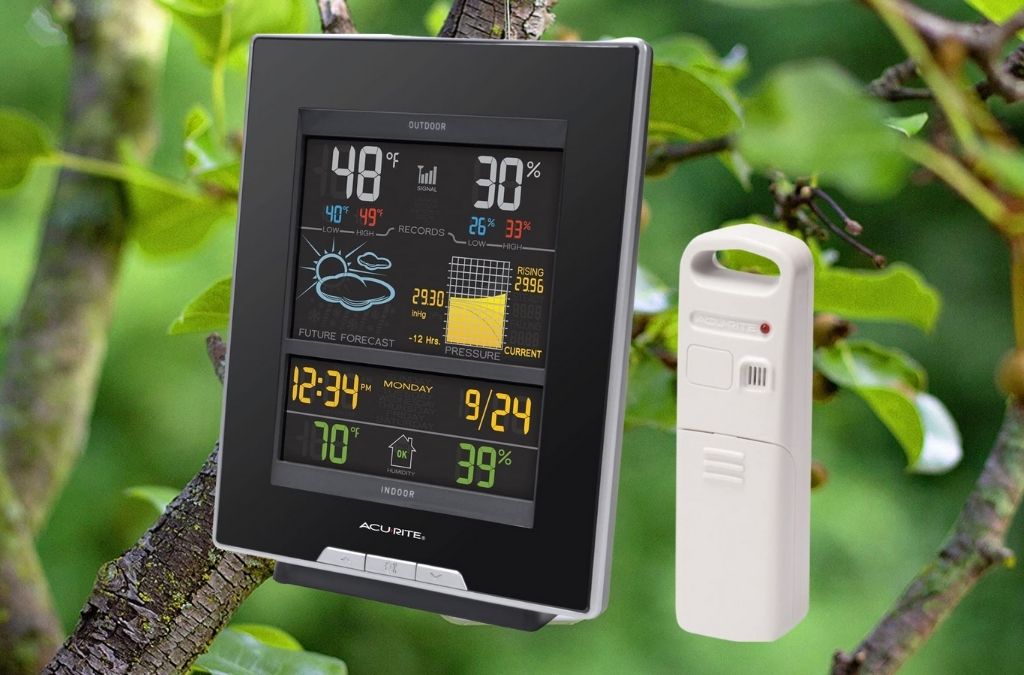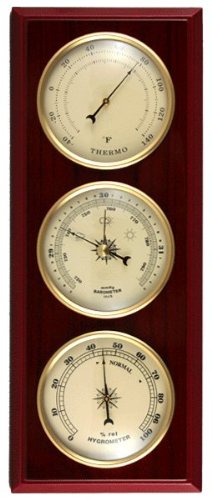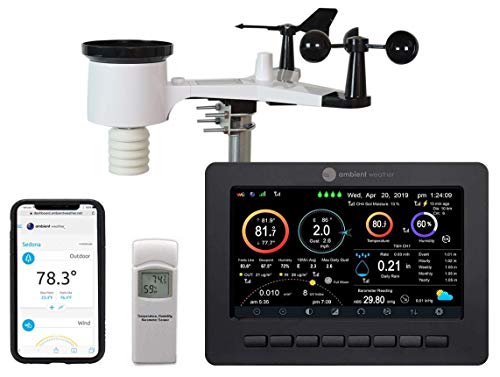Imagine a world with no weather stations! How would we predict if tomorrow was going to be sunny, rainy, or cloudy? More importantly, how would we prepare ourselves for any natural calamity?
Weather stations or weather centers are tech-savvy devices that collect, analyze, and record information about the weather and climate. They utilize various sensors and other equipment to collect and analyze data about the atmospheric conditions. Once analyzed, the results can be used to predict accurate weather forecasts, based on hostorical data.
Jump ahead to:
Why Are Weather Stations Important?
Weather stations are a necessity, as they help us to predict the weather. Being able to forecast the weather plays a vital role in our lives. Knowing what the weather will be like today or tomorrow influences the way we dress, our plans, and even our preparations to face natural disasters.
Accurate weather forecasting is also essential for farming, fishing, and aviation.
The goal of weather stations is to provide people and organizations with the information (weather forecasts) to prevent weather-related losses (both life and property). Knowing what weather is coming also has societal benefits such as economic prosperity and increased quality of life.
What Do Weather Stations Analyze?
Located both on land and sea (ships and buoys), weather stations forecast the weather by measuring the atmospheric conditions of a particular area and its surroundings. This includes measuring and analyzing the atmospheric temperature, pressure, humidity, wind speed and direction, rainfall, and snowfall.
This is done by use of various weather instruments.
Weather Stations Use These Instruments
Thermometers
Measure atmospheric temperatures, recording the high and lower limits.
The data collected is analyzed to identify temperature trends (rise and fall of temperature), and to predict future temperature ranges.
Traditionally, it was mercy thermometers that were used. Mercury being temperature-sensitive would expand and contract at high and low temperatures respectively. These differences would cause the mercury to rise in its glass casing (later plastic.)
Present-day thermometers are mostly digital, tracking and recording information directly to the weather stations console or a computer.
We found these best selling thermometers on Amazon
Hygrometers
Relative humidity of the atmosphere, which is the quantity (as a percentage) of water vapor in the air, is measured using a hygrometer. This is done by calculating factors such as dew, heat index and precipitation.
Measurement of relative humidity is essential as too high or low humidity has a negative impact on both our health and homes. Think of nasty mold and mildew growing in your home!
Most modern day weather stations monitor indoor humidity as well.
Here are the best selling hygrometers for weather stations on Amazon.
Last update on 2025-06-16
Last update on 2025-06-21
Barometers
Atmospheric pressure changes are tracked and measured using a barometer. Weather changes are indicated by changes in atmospheric pressure.
For instance, clear skies are expected when air pressure rises and forms a high-pressure cell. Therefore, lowered pressure and the formation of a low pressure cell indicates a storm.
Anybody who suffers from barometric pressure headaches can benefit greatly from the information provided by modern weather stations.
Here are the best selling barometers on Amazon.
Last update on 2025-06-21
Anemometer
Wind speed is measured using an anemometer. It records the peak and average speed of the wind and records it in knots, MPH or KPH.
Most weather stations use cup anemometers mounted on a pole for greater accuracy. However, the top of the line Ambient Weather WS-5000 Ultrasonic Smart Weather Station has integrated an ultrasonic anemometer. Not only does it have greater accuracy, with no moving parts there is zero wear and tear, no maintenance and it lasts longer.
Check out these best selling anemometers on Amazon.
Wind Vane
The direction the wind is blowing is determined using a wind vane or weather vane. Most wind vanes have an anemometer attached to them to track the speed of the wind.
Traditionally, every farmhouse or barn in the USA had a wind vane mounted to its roof. Less common today, they are still highly popular in rural areas and offer important weather information.
Look at these best selling wind vanes for weather stations on Amazon.
Rain Gauge
Measures the amount of rainfall or precipitation over a given time. Found in all weather stations, modern units include features such as self-emptying buckets.
Check out these best-seller rain gauges on amazon;
Last update on 2025-06-20
Weather Instruments Not Used With Weather Stations
Windsocks
This is another tool that can measure both the speed and direction of the wind. It is commonly seen in airports as air traffic controllers and pilots have to consider the speed and direction of the wind when charting flight plans.
Although not used with weather stations, they are a fun weather instrument to have at home.
Check out these best seller windsock weather station on Amazon.
Last update on 2025-06-21
Radiosondes
These are also known as weather balloons. They measures atmospheric components (temperature, pressure, and humidity), wind speed, and direction as they float through the air.
Some radiosondes help monitor storms. They are dropped from an airplane and as they descend the unit measures atmospheric conditions inside the storm cell.
We found these radiosondes on Amazon.
Weather Satellites
These are increasingly used to collect data about the weather, especially storms, and long-term changes like melting ice caps.
Weather satellites offer information that cannot be collected by weather stations.
The two main types of satellites are:
Geostationary Operational Environmental Satellites
(GOES): Operated by the National Oceanic and Atmospheric Administration (NOAA)’s National Environmental Satellite, Data, and Information Service division of the United States. The GOES satellite is 35,790 kilometers above the planet.
It is ‘geo-fixed’ on a specific location and rotates around Earth, collecting information continuously.
The three basic types of GOES imagery include:
- Visible – light records images of clouds, storms, fires, and smogs.
- Infrared – monitors and records temperatures of both land and sea, and oceanic currents.
- Water vapor imagery – analyzes the moisture content in the higher atmospheric levels, in order to determine the formation of thunderstorms.
Polar Orbiting Environmental Satellite (POES):
They fly closer to the earth, about 530 miles away, and orbit around Earth pole-to-pole.
How Weather Stations Can Forecast The Weather
Scientists, meteorologists and weather forecasters collect, compile and compute conditions and patterns of an areas weather and atmospheric readings. This data is run through a computer to find trends and patterns of weather readings. These computer-generated models are analyzed and studied in order to predict the weather.
Earlier, meteorologists had to manually collect and calculate this information. However, as technology advances, weather stations are becoming automated. Now-a-days, readings are automatically recorded and transferred to the computer within the display console or transmitted to a larger database.
Modern weather stations do all the predicting for you!
Types of Weather Stations
Once you start to look into home weather stations, you will find many variables. Price, included sensors, cabled or WiFi, smart home connectivity and specifications will vary for each brand and model.
There are many different brands available, with some of the top names featuring on every list of best home weather stations.
- Ambient Weather
- Acurite
- Davis
- Tempest
- Sainlogic
- Netatmo
Personal Home:
These can be simple or advanced monitors that digitally display the basic information about the temperature and humidity indoors.
Check out this best-seller personal/home weather station on Amazon;
Last update on 2025-06-21
Wireless Indoor/Outdoor:
These units use remote monitors to track and display the temperature and humidity both indoors and outdoors.
A digital display in full colour or black and white can also show the time and phases of the moon. In fact, these best-selling weather stations can forecast the weather for up to 48 hours and send data to various networks online.
Last update on 2025-06-23
Complete Wireless:
These comprehensive models are connected to the WIfi and can access the National Weather Service feeds to provide weather forecasts. Advanced models, they are designed for weather enthusiasts and can display information on temperature (high and low range of temperature), pressure, precipitation, wind speed and direction, dew point as well as moon phase.
Our list of complete weather stations will provide any data you could wish for and are perfect for many professions. Farmers and graziers, landscape and garden experts, elite sportspeople, surfers and any marine enthusiast will benefit from these top home weather stations. Or, you could invest in a professional weather station.
Last update on 2025-06-20
Congratulations! you made it through this article and now have a better understanding of what weather stations do.
If you have any questions or have some feedback about this article, please leave a comment below.
To dive deeper on different weather station instruments use the following links:
The Best Mounted Anemometers For Home Use In 2021






























